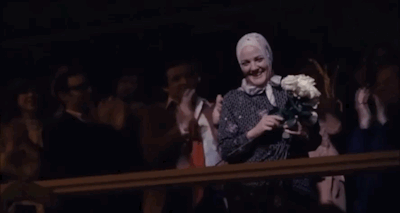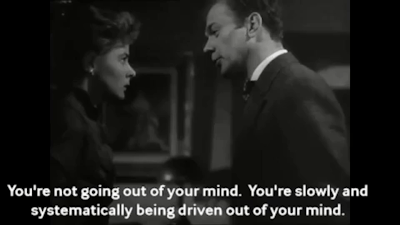Each year we devote one day to honoring the women who set us on our fist steps of life's journey; our mothers. For better or for worse our mothers shape who we are and inspire who we ultimately become. Few stories capture the impact of maternal love in all of its complexity as that of mother and daughter 'Big Edie' and 'Little Edie' Beale. The 1975 documentary Grey Gardens catapulted the duo to a fame bordering upon notoriety the likes of which would not be seen again until the advent of reality television. The film depicted the pair in their full co-dependency and eccentricity but left viewers begging the question of how did these two women plummet from the echelons of high society to abject squalor. The 2009 HBO film Grey Gardens answers just that question and more as it relates a tale "oozing with romance, ghosts, and other things".
 |
| Staunch women....S-T-A-U-N-C-H |
The story begins in 1975 with mother and daughter living in squalor in their dilapidated Hamptons mansion. After the pair's famous cousin, Lee Radziwell, abandons her plan for a documentary chronicling the entire Bouvier clan, the film's makers Albert and David Maysles set their sights on the Beales. The Maysles see the bizarre existence of Big Edie and Little Edie as having cinematic potential and approach the pair about starring in their own documentary. The Edies gleefully accept the offer and begin the process of making the cult classic Grey Gardens. The series then flashes back to reveal the story behind the story as it chronicles Big Edie's fall from socialite to recluse and Little Edie's descent from daring debutante to repressed spinster. Over the ensuing decades the women endure disillusionment, heartbreak, and the torment of wondering what might have been, but through it all they remain devoted to one another and firm in their belief that "when we are together we know we are where we belong".
When HBO first announced their plans audiences wondered why the network would make a movie about two women who were already the subject of a documentary and a Tony Award winning Broadway musical. As soon as the film enters its first flashback to the 1930's, however, it becomes apparent that the original documentary only scratched the surface of the stranger than fiction story of the Beales. Through a series of flashbacks the film reveals how Big Edie and Little Edie began as a pair of endearingly eccentric socialites who personified the culture and class of pre-war high society. While the pair's lifestyle glittered to outsiders, however, the film reveals that behind closed doors the Beales' lives were less than golden. The film then goes on to chronicle the ways in which the women suffered personal heartbreaks, professional disappointments, and financial losses that upended their very existence. Even as they struggled to adjust to personal traumas the pair were set further adrift by the tumult of the Great Depression and World War II, which rendered the lives of leisure and luxury that they enjoyed obsolete. Rather than adapt to personal and social changes, however, mother and daughter retreated into their relationship with each other until they became an entire world unto themselves. The film then follows the ways in which their relationship evolved from close to codependent with their bond playing the dual role of refuge and prison. Through its multi-faceted portrayal of the pair's unusual relationship the film offers a fascinating portrait of maternal love that is every bit as by turns tragic, triumphant, and ultimately unforgettable as the Beales themselves. Make life a song this mother's day with Big Edie and Little Edie in Grey Gardens.
 |
| Mother and I are very entertaining, that's true... |
The stellar cast brings both the iconic scenes of the original documentary and the story behind the camera to vivid life. Malcolm Gets is a delight in his Gene Kelly-esque turn as Big Edie's best friend and piano instructor Gould. Ken Howard garners sympathy as practical and put upon Phelan Beale. Jeanne Tripplehorn imbues her performance as Jacqueline Kennedy with a world weariness, elegance, and mystique worthy of the iconic first lady. Daniel Baldwin strikes an ideal balance between sleaze and suave as Little Edie's married lover, Julius Krug. Arye Gross and Louis Ferreria aptly convey the Maysles' dismay and fascination as they witness Grey Gardens in all of its grotesque splendor. Even in the midst of an exemplary supporting cast Jessica Lange and Drew Barrymore dominate the screen as Big Edie and Little Edie. During Big Edie's younger years Lange imbues her with a socialite's charisma while hinting at the mental illness and dependency lurking beneath the surface. As Big Edie ages Lange recreates scenes from the documentary with eerie accuracy without sacrificing any nuance or emotion. Barrymore is the ultimate ingenue in the scenes depicting Little Edie's youth as she perfectly captures Little Edie's eager naivete with infectious charm. In the scenes depicting Little Edie's later years Barrymore transitions to a darker, more complex performance as she effortlessly portrays the bitterness, regret, and longing of a woman whose life seems to have passed her by. Together the pair make a formidable team guaranteed to have viewers soft shoeing right along with them.
HBO's Grey Gardens reveals the story behind the infamous cult classic documentary and pays apt homage to motherhood in all of its complexity and grey areas. The script offers valid insight into the inner workings of Big Edie and Little Edie and approaches both women with empathy without losing sight of their flaws. The performances revive scenes from the original documentary with eerie accuracy while still adding new depths to each of the characters. For the mother of all mother daughter tales enjoy tea for two with Big Edie and Little Edie at Grey Gardens.
 |
| A revolutionary costume |






